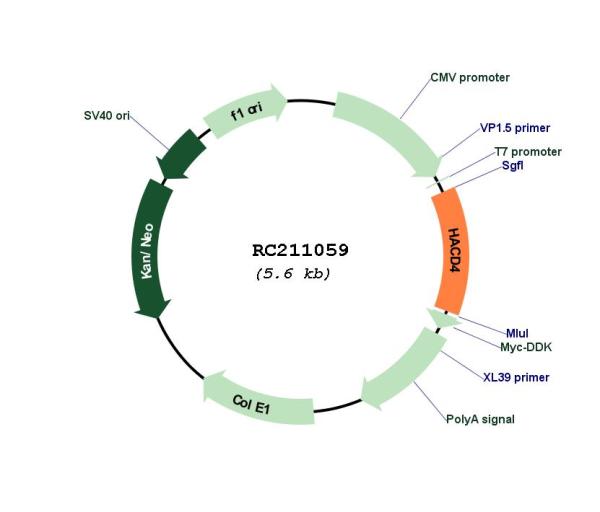PTPLAD2 (HACD4) (NM_001010915) Human Tagged ORF Clone
CAT#: RC211059
PTPLAD2 (Myc-DDK-tagged)-Human protein tyrosine phosphatase-like A domain containing 2 (PTPLAD2)
ORF Plasmid: tGFP
Lentiviral Particles: DDK w/ Puro mGFP w/ Puro
AAV Particle: DDK
"NM_001010915" in other vectors (4)
USD 198.00
Specifications
| Product Data | |
| Type | Human Tagged ORF Clone |
| Tag | Myc-DDK |
| Symbol | PTPLAD2 |
| Synonyms | PTPLAD2 |
| Vector | pCMV6-Entry |
| E. coli Selection | Kanamycin (25 ug/mL) |
| Mammalian Cell Selection | Neomycin |
| Sequence Data |
>RC211059 ORF sequence
Red=Cloning site Blue=ORF Green=Tags(s) TTTTGTAATACGACTCACTATAGGGCGGCCGGGAATTCGTCGACTGGATCCGGTACCGAGGAGATCTGCC GCCGCGATCGCC ATGGGGCCCTTGGCGCTGCCCGCCTGGCTGCAGCCCAGGTATAGGAAGAATGCGTATCTTTTCATCTATT ACTTAATCCAGTTCTGTGGCCACTCTTGGATATTTACAAATATGACAGTCAGATTCTTTTCATTTGGAAA AGATTCAATGGTTGACACTTTTTATGCTATTGGACTTGTGATGCGACTTTGCCAATCCGTATCTCTCCTG GAACTGCTGCACATATATGTTGGCATTGAGTCAAACCATCTTCTCCCAAGGTTTTTGCAGCTCACAGAAA GAATAATCATCCTTTTTGTGGTGATCACCAGTCAAGAGGAAGTCCAAGAGAAATATGTGGTGTGTGTTTT ATTCGTCTTTTGGAATCTATTGGATATGGTTAGGTACACTTATAGCATGTTATCAGTCATAGGAATATCC TATGCTGTCTTGACATGGCTCAGTCAAACACTATGGATGCCAATTTATCCTTTGTGTGTTCTTGCTGAAG CATTTGCCATCTATCAATCGCTGCCTTATTTTGAATCATTTGGCACTTATTCCACCAAGCTGCCCTTTGA CTTATCCATCTATTTCCCATATGTGCTGAAAATATATCTCATGATGCTCTTTATAGGTATGTATTTTACC TACAGTCATCTATACTCAGAAAGAAGAGACATCCTCGGAATCTTTCCCATTAAAAAAAAGAAGATG ACGCGTACGCGGCCGCTCGAGCAGAAACTCATCTCAGAAGAGGATCTGGCAGCAAATGATATCCTGGATT ACAAGGATGACGACGATAAGGTTTAA >RC211059 protein sequence
Red=Cloning site Green=Tags(s) MGPLALPAWLQPRYRKNAYLFIYYLIQFCGHSWIFTNMTVRFFSFGKDSMVDTFYAIGLVMRLCQSVSLL ELLHIYVGIESNHLLPRFLQLTERIIILFVVITSQEEVQEKYVVCVLFVFWNLLDMVRYTYSMLSVIGIS YAVLTWLSQTLWMPIYPLCVLAEAFAIYQSLPYFESFGTYSTKLPFDLSIYFPYVLKIYLMMLFIGMYFT YSHLYSERRDILGIFPIKKKKM TRTRPLEQKLISEEDLAANDILDYKDDDDKV |
| Chromatograms |
CHROMATOGRAMS
 Sequencher program is needed, download here. |
| Restriction Sites |
SgfI-MluI
Cloning Scheme for this gene
Plasmid Map

|
| ACCN | NM_001010915 |
| ORF Size | 696 bp |
| OTI Disclaimer | The molecular sequence of this clone aligns with the gene accession number as a point of reference only. However, individual transcript sequences of the same gene can differ through naturally occurring variations (e.g. polymorphisms), each with its own valid existence. This clone is substantially in agreement with the reference, but a complete review of all prevailing variants is recommended prior to use. More info |
| OTI Annotation | This clone was engineered to express the complete ORF with an expression tag. Expression varies depending on the nature of the gene. |
| Product Components | The ORF clone is ion-exchange column purified and shipped in a 2D barcoded Matrix tube containing 10ug of transfection-ready, dried plasmid DNA (reconstitute with 100 ul of water). |
| Reconstitution | 1. Centrifuge at 5,000xg for 5min. 2. Carefully open the tube and add 100ul of sterile water to dissolve the DNA. 3. Close the tube and incubate for 10 minutes at room temperature. 4. Briefly vortex the tube and then do a quick spin (less than 5000xg) to concentrate the liquid at the bottom. 5. Store the suspended plasmid at -20°C. The DNA is stable for at least one year from date of shipping when stored at -20°C. |
| Reference Data | |
| RefSeq | NM_001010915.5 |
| RefSeq Size | 1416 bp |
| RefSeq ORF | 699 bp |
| Locus ID | 401494 |
| UniProt ID | Q5VWC8 |
| Cytogenetics | 9p21.3 |
| Protein Families | Transmembrane |
| MW | 27.5 kDa |
| Gene Summary | Catalyzes the third of the four reactions of the long-chain fatty acids elongation cycle. This endoplasmic reticulum-bound enzymatic process, allows the addition of two carbons to the chain of long- and very long-chain fatty acids/VLCFAs per cycle. This enzyme catalyzes the dehydration of the 3-hydroxyacyl-CoA intermediate into trans-2,3-enoyl-CoA, within each cycle of fatty acid elongation. Thereby, it participates in the production of VLCFAs of different chain lengths that are involved in multiple biological processes as precursors of membrane lipids and lipid mediators.[UniProtKB/Swiss-Prot Function] |
Documents
| Product Manuals |
| FAQs |
| SDS |
Resources
Other Versions
| SKU | Description | Size | Price |
|---|---|---|---|
| RC211059L3 | Lenti ORF clone of Human protein tyrosine phosphatase-like A domain containing 2 (PTPLAD2), Myc-DDK-tagged |
USD 600.00 |
|
| RC211059L4 | Lenti ORF clone of Human protein tyrosine phosphatase-like A domain containing 2 (PTPLAD2), mGFP tagged |
USD 600.00 |
|
| RG211059 | PTPLAD2 (tGFP-tagged) - Human protein tyrosine phosphatase-like A domain containing 2 (PTPLAD2) |
USD 500.00 |
|
| SC301529 | PTPLAD2 (untagged)-Human protein tyrosine phosphatase-like A domain containing 2 (PTPLAD2) |
USD 300.00 |
{0} Product Review(s)
Be the first one to submit a review






























































































































































































































































 Germany
Germany
 Japan
Japan
 United Kingdom
United Kingdom
 China
China




